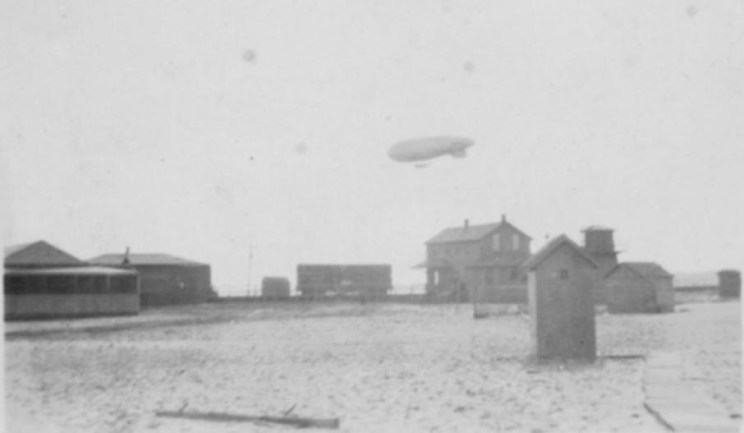
When this blimp lifted off from Montauk on May 14, 1919, some hoped it would set a record by making a trip across the Atlantic to Ireland, eight years before Charles Lindbergh’s flight to Paris.
During World War I the Navy operated a 33-acre air base near what is today’s downtown. Open fields provided a landing space for dirigibles like the one above; Fort Pond provided a surface for seaplanes to lift off from to patrol the coast. A hangar housing two huge dirigibles was about 10 stories tall – taller than “the Tower” now standing at the site. The naval base included barracks for more than 400 men as well as a hospital, machine shop, and power plant.


Aviation technology advanced rapidly during the war, and when it ended the race was on between the different types of flying machines – those lighter than air, like blimps or dirigibles, and those heavier than air, like seaplanes and fixed-wing planes. The C-5 was one of the latest types of dirigibles, the East Hampton Star reported when one traveled from its home base in Cape May, New Jersey, to depart from Montauk for what was hoped would be a pioneering excursion.
“The Montauk Naval Air Station was put on the map this week,” the Star reported, “when the C-5, the U.S. Navy dirigible, which will attempt to make the trans-Atlantic flight, made this station a starting point for the long flight to St. Johns.” Although they made good time, the airship’s commander said the 1,400-mile journey to St. Johns, Newfoundland, had been “the roughest trip he had ever experienced.”
At St. Johns, the crew slept and the C-5 was refueled to prepare for the final leg of the trip to Ireland. But the weather took an unexpected turn, with gusts imperiling the ground crew and forcing them to abandon the ship.
“Scarcely had officers of the navy this afternoon ceased sounding the praise of the dirigible C-5 for its splendid run from Montauk Point to Newfoundland,” said a New York Times story on May 16, “… than word was flashed to the Navy Department … that the C-5 had broken off its moorings and drifted out to sea without her crew.”
No one was hurt, but the C-5 was never recovered.


Reply or Comment